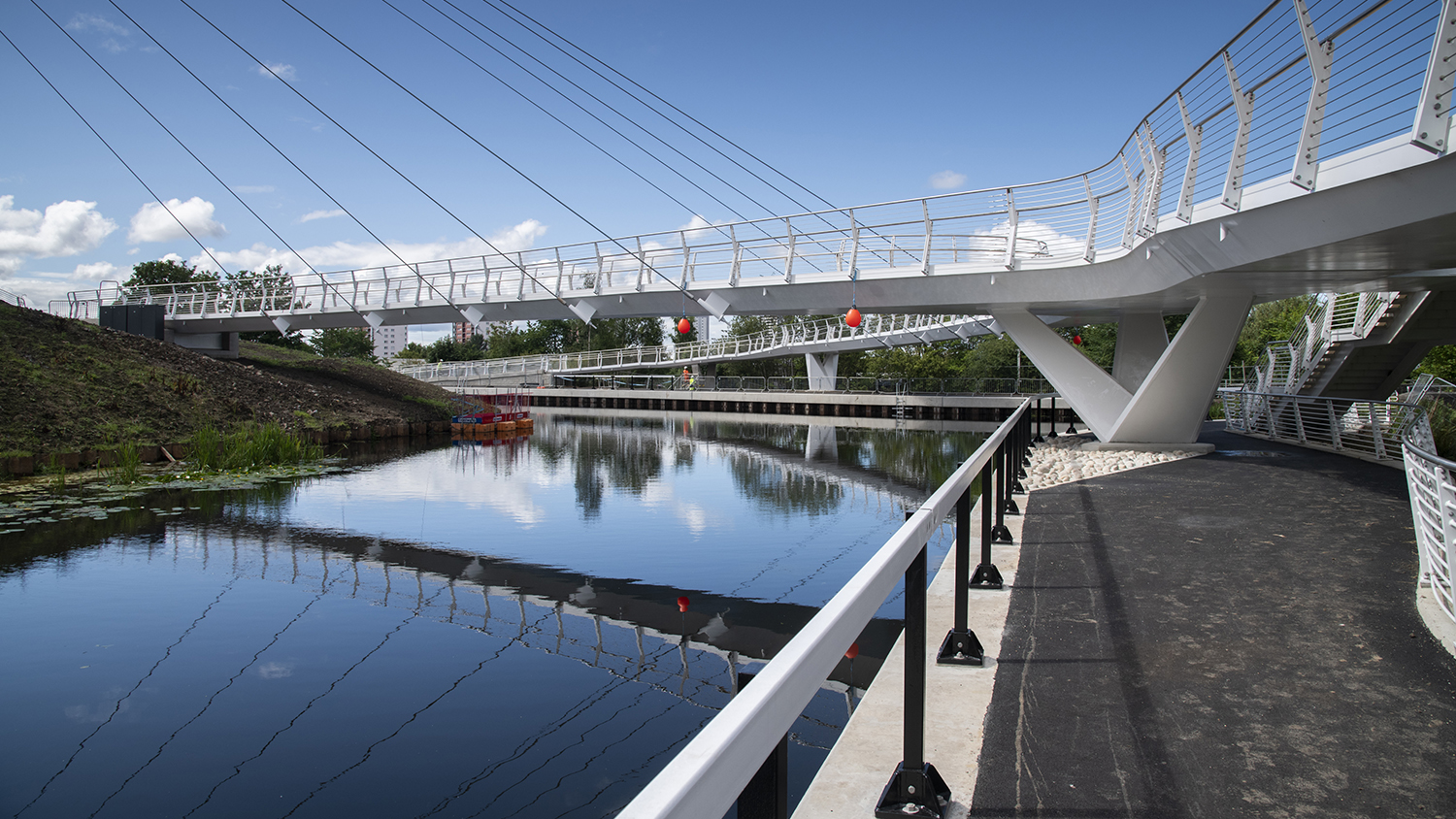
Funded by the Scottish Government through Sustrans, and Glasgow City Council’s Vacant Derelict Land Fund, a new bridge reconnects the communities in north Glasgow and completes the last link in the Forth and Clyde Canal towpath
Allowing pedestrians and cyclists to cross a canal at towpath level, instead of having to use a potentially dangerous road tunnel, the £13.7m Stockingfield Bridge has opened up routes for leisure and employment in Glasgow.
Award: Stockingfield Bridge, Glasgow
Structural engineer: Jacobs
Steelwork contractor: S H Structures Ltd
Main contractor: Balfour Beatty
Client: Scottish Canals
The 3.5m-wide bridge comprises two curved single-span decks suspended on a network of cables connected to a single inclined pylon situated on the east bank of the canal.
The client was keen that community engagement played a vital part in the project’s ultimate success. Residents and community groups were consulted from concept to completion, giving them a real sense of ownership. High on the residents’ original wish list were attractive landscaping, a viewing point and the inclusion of public art, all of which have been provided.
In addition, to ensure that the space is safe for female users, the project team worked with a Glasgow violence against women and girl’s charity, Wise Women. As part of this collaboration, local women visited the site and provided feedback on lighting, access and layout.
Following the initial community engagement 14 submissions were received for potential artwork to be included on the site and eight were selected. These include ceramic panels and paving stones based on community-produced artworks.
Number of challenges
The steel fabrication and assembly of the bridge and mast presented a number of challenges. Heavily plated structures, such as the bridge’s curved, tapering, trapezoid-shaped twin decks, are prone to weld shrinkage and distortion during fabrication.

The use of bespoke jigs, welding control and dimensional monitoring were all employed to eliminate the risks. The project team also redesigned the internal stiffening configuration of the bridge decks to reduce the number of longitudinal stiffeners and transverse diaphragms, used to control plate buckling, by up to 50%.
This reduced not only the steel weight, saving both cost and carbon, but also, crucially, the amount of welding required, which in turn reduced heat-induced distortion.
“Other materials for the bridge were considered, such as concrete and timber,” says S H Structures sales director Tim Burton. “Steel was selected as it was the most structurally efficient and cost-effective solution.”
Temporary canal closure
The construction team considered various options for the installation methodology. Taking into consideration time, cost, safety and environmental issues, the solution chosen required the temporary closure of the canal. The waterway’s sides were protected with sheet piles and, using carefully selected fill material, temporary working platforms, or causeways, were created within the waterway to facilitate the bridge construction.
“This is a well-conceived, finely executed project providing significant practical and social value, with new links between disconnected communities and much-needed pedestrian and cycle routes.”
The desire to reduce carbon within the project’s construction programme played an important part in the design and the selection of materials.
Various initiatives were introduced to reduce the project’s carbon footprint. As well as the redesign of the bridge decks’ internal stiffening, these included the reuse of the temporary causeway material as part of the site’s landscaping, the use of recycled materials in the asphalt and sustainable cement replacements in the concrete mixes.
Summing up, the judges say this is a well-conceived, finely executed project providing significant practical and social value, with new links between disconnected communities and much-needed pedestrian and cycle routes across a canal and adjacent road.
Produced by BCSA and Steel for Life in association with Construction Management











